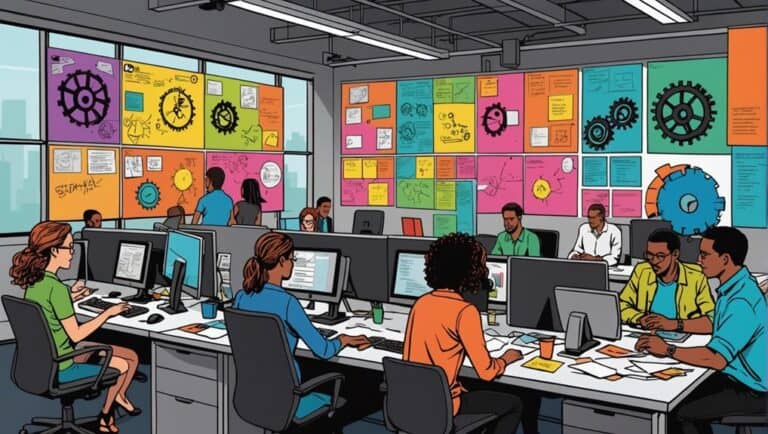Understanding Agile Methodology
You may find it helpful to understand the principles and practices of a more flexible and iterative approach to project management, otherwise known as Agile methodology. Agile principles emphasize adaptability, collaboration, and continuous improvement. The Scrum framework, one of the most popular methods within Agile, involves breaking down a project into smaller, more manageable tasks and completing them in short iterations called sprints. Agile methodology is particularly useful for organizations that prioritize innovation and creativity. By breaking a project into smaller tasks, teams can quickly test and adjust their approach in response to feedback. This allows for greater flexibility and agility in the face of changing circumstances. Additionally, Agile promotes collaboration between different teams and stakeholders, helping to ensure that everyone is working towards the same goals. However, Agile may not be the best fit for all organizations. It requires a high degree of communication and coordination between team members, which can be difficult in larger organizations. Additionally, the iterative nature of Agile can lead to unexpected delays or changes in scope, which may be challenging for organizations with strict deadlines or budgets. Ultimately, the decision to use Agile or another methodology should be based on the specific needs and goals of your organization.Understanding Waterfall Methodology
So you want to know how a step-by-step approach to project management can help you effectively plan and execute tasks? Let’s dive into the waterfall methodology. This methodology is a linear and sequential process that divides the project into distinct phases. Each phase must be completed before moving onto the next one. The waterfall process steps include initiation, planning, design, execution, monitoring, and closure. In the initiation phase, the project’s objectives and scope are identified, and the project team is assembled. The planning phase involves creating a detailed project plan that outlines the project’s requirements, milestones, and timelines. The design phase involves designing the project’s architecture and infrastructure. In the execution phase, the project team works to complete the project plan’s tasks. The monitoring phase involves tracking the project’s progress and making changes as required. Finally, the closure phase involves delivering the completed project to the stakeholders. Waterfall project examples include building a house, creating a software application, or constructing a bridge. This methodology is best suited for projects where the requirements are well understood, the scope is clearly defined, and there is a clear understanding of what the final deliverable should look like. However, it can be challenging to make changes once the project has advanced beyond a particular phase. Overall, understanding the waterfall methodology is essential for managing projects effectively. By following the step-by-step approach, you can ensure that each phase of the project is completed before moving onto the next one. However, it’s crucial to consider the project’s requirements, scope, and complexity before deciding whether the waterfall methodology is the right approach for your project.Pros and Cons of Agile Methodology for Change Management
Oh, boy, you’re in for a treat! We’re about to explore the upsides and downsides of this newfangled approach to project management that everyone’s buzzing about. Agile methodology is all the rage these days, and it’s not hard to see why. Here are three benefits of using agile methodology for change management: 1. Flexibility: Agile methodology allows for more flexibility and adaptability than traditional waterfall methodology. With agile, you can adjust your plans as you go along, based on feedback and changing circumstances. 2. Collaboration: Agile methodology emphasizes collaboration and teamwork, which can lead to better outcomes and more creative solutions. By working closely with stakeholders and team members, you can identify issues and opportunities more quickly and effectively. 3. Faster results: Because agile methodology involves working in shorter sprints, you can see results more quickly than with waterfall methodology. This can help keep stakeholders engaged and motivated, and can help you make adjustments more quickly if needed. Of course, there are also drawbacks to using agile methodology for change management. Here are a few to keep in mind: 1. Lack of structure: Agile methodology can sometimes be seen as too loose or unstructured, which can make it difficult to manage larger projects or teams. Without a clear plan in place, it can be easy to get sidetracked or lose sight of your goals. 2. Communication challenges: Because agile methodology relies so heavily on collaboration and communication, it can be challenging to keep everyone on the same page. This is especially true if team members are working remotely or across different time zones. 3. Resource constraints: Agile methodology can require more resources and personnel than traditional waterfall methodology, particularly in the early stages of a project. This can make it difficult to get buy-in from stakeholders or secure the resources you need to get started. As you can see, there are pros and cons to using agile methodology for change management. Ultimately, the best approach will depend on the specific needs and goals of your organization. It’s important to weigh the benefits and drawbacks carefully and to consider how agile methodology might fit into your overall change management strategy.Pros and Cons of Waterfall Methodology for Change Management
If you’re looking for a methodology that provides a linear approach and a structured process, the waterfall methodology may be a good choice for your change management. This methodology is known for its step-by-step approach, where each phase of the project is completed before moving on to the next one. This makes it an ideal method for large and complex projects with a defined scope. Waterfall methodology helps organizations to stay on track by providing a clear roadmap for the entire project. This structured approach also makes it easier to manage resources and enables effective communication among team members. It’s also easier to measure progress and ensure that the project stays within scope and budget. However, the slow pace of the waterfall methodology can be a disadvantage. This method can take a long time to complete, which can be frustrating for stakeholders who want to see results quickly. Additionally, the limited flexibility of the method means that it may not be ideal for projects with changing requirements. In such cases, an agile approach may be more suitable.Choosing the Right Methodology for Your Change Management Strategy
Choosing the right approach for managing change is crucial, and understanding the success rates of different methodologies can help guide your decision-making process. When it comes to choosing between agile and waterfall methodologies, there are a few factors to consider. Firstly, you need to assess the change management challenges you’re facing. If you’re dealing with a complex change that requires significant planning and documentation, the waterfall methodology may be the best option. However, if you need more flexibility and adaptability, agile may be the preferred choice. Secondly, implementation considerations are important when choosing a methodology. Waterfall projects tend to be more time-consuming and require more resources, as the entire project must be completed before any testing or deployment can occur. This can be a disadvantage if you need to implement changes quickly. On the other hand, the iterative nature of agile can allow for earlier testing and deployment, which can result in a faster implementation process. However, it’s important to note that agile requires more collaboration and communication among team members, which can be challenging if you have a large team or are working remotely. Ultimately, the decision between agile and waterfall comes down to your specific change management needs and priorities. Both methodologies have their strengths and weaknesses, and it’s up to you to determine which one will be the most effective for your organization. By considering the change management challenges you’re facing and the implementation considerations that are most important to you, you can make an informed decision that’ll help ensure the success of your change management strategy.How Does Agile Methodology Compare to Waterfall in Change Management?
In change management, the role of agile change management stands in stark contrast to traditional waterfall methods. Agile methodology emphasizes flexibility, collaboration, and iterative processes, enabling quicker adjustments and smoother transitions. Unlike the linear and rigid nature of waterfall, the agile approach promotes adaptability and faster response to change.





